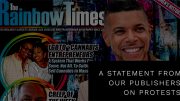
Gary J. Gates, Williams Distinguished Scholar at the Williams Institute, UCLA School of Law
Photo: Larry Gates, One Photography
By: Chuck Colbert /TRT Reporter—
There are an estimated 1.4 million adult LGBT Latin@s in the U.S., according to a recently released report from a Southern California-based think tank. With 4.3 percent of Latin@ adults identifying as LGBT, that number means they are the largest ethnic or racial minority, including LGBT African Americans and LGBT Asian/Pacific Islanders. The numbers for African Americans and Asian/Pacific Islanders are 1 million (or 3.7 percent) and 324,600 (or 2.8 percent), respectively.
“There’s a common stereotype in LGBT community that the number who identify as racial or ethnic minorities is somehow lower than in the white community,” said Gary J. Gates, a co-author of the studies.
According to Gates, “In looking at the details of the report, these minorities in the LGBT community, like in the U.S., are younger. What we are seeing is that LGBT’s are coming out at a much earlier age, and that’s true in racial and ethnic minorities,” which explains “the higher levels of LGBT identification.” [pullquote]What we are seeing is that LGBT’s are coming out at a much earlier age, and that’s true in racial and ethnic minorities,” which explains “the higher levels of LGBT identification.”[/pullquote]
“The rate of identification as LGBT is twice as high among under 30 than among 30 or older,” said Gates.
Gates is a distinguished scholar at the Williams Institute, UCLA School of Law. The Williams Institute published all three reports in the past two months. The studies were based on a Gallup Daily tracking survey, 2008-2010 American Community Survey, and adjustments to Census 2010 same-sex couple data.
In all, nearly 60 percent of LGBT Latin@ adults in the U.S. live in California, Florida, New York, and Texas, according to the Williams Institute report. The number of LGBT Latin@ individuals in same-sex relationships is 146,000, with 29 percent of the Latin@ same-sex couples raising children. These couples tend to live in areas with higher proportions of Latin@s in the general population. For example, a third of Latin@ same-sex couples live in New Mexico, California and Texas. The top three states for percent of LGBT Latin@ individuals are Texas, Nevada and California.
In other key findings, certain subgroups within the Latin@ LGBT population show signs of socioeconomic vulnerability, the study found. For example, reported median household incomes for Latin@ same-sex couples raising children are 20 percent below the income of same-sex couples without children. At the same time, while individuals of Spanish or Cuban ancestry report higher education levels, Mexican, Salvadoran and Puerto Rican individuals report lower rates of college graduation. [pullquote]The number of LGBT Latin@ individuals in same-sex relationships is 146,000, with 29 percent of the Latin@ same-sex couples raising children.[/pullquote]
In another key finding, LGBT Latin@ individuals in same-sex relationships are more likely to be U.S. born (59 percent) than Latin@ individuals in different-sex couples (37 percent). The top three locations of origin for Latin@ individuals in same-sex couples born off the U.S. mainland are Mexico, Puerto Rico and Cuba.
LGBT Latin@-specific data to Massachusetts and New England are not included in the Williams Institute study, but local gay Latino activist Wilfred Labiosa said, “The Williams Institute Report on LGBT Latino/a individuals and same sex couples doesn’t surprise me as Latinos are the highest growing group in our nation.”
He added: “Many of the Latino/a in the state of Massachusetts also reflect some of the findings of this report in regards to raising children, highest rates of underemployment or unemployment, depression/suicide attempts, and of struggling among our communities, that being the Latino community or the LGBT community.”
Labiosa is regional representative of Unid@s: The National Latin@ LGBT Human Rights Organization. He is also a Spanish language columnist for The Rainbow Times.
“For many years, Latin@s struggle[d] between these two worlds,” Labiosa said. “There are some who successfully can fit in one or the other or in both, but this is the minority and not the majority due to the ‘-isms’ that still exist among our society, such as homophobia, classism and racism, among others. As a community, we must unite and work together to find support and resources available to us in order to find the strength that is within us, but that is hard to find when feeling isolated and marginalized.”
In other news, The Rainbow Times-specific demographic data from Community Marketing Inc.’s 7th Annual LGBT Community Survey for 2013 indicated that anywhere from 15 to 25 percent of the publication’s readers identify as Latin@.
The Rainbow Times is one of few LGBT publications nationwide with Spanish language editorial content. Accordingly, for LGBT media outlets, Gates said, there lies a challenge “to go beyond tokenism.”
“What more contemporary data shows is that as social acceptance increases, the demographic differences we associate with LGBT people are starting to lessen because they are starting to look more like the general population,” said Gates.
Gates said years ago, people who came out tended to be “somewhere on the economically advantaged side, who could take the risk sooner.” These days, he said, “The perceived risks are not necessarily as high, and people don’t perceive as bad a risk now” in coming out. [pullquote]The Rainbow Times is one of few LGBT publications nationwide with Spanish language editorial content. Accordingly, for LGBT media outlets, Gates said, there lies a challenge “to go beyond tokenism.”[/pullquote]
“We are getting more racial and ethnic diversity, more socio-economic diversity, and that means, for media at least, this idea of an exclusive LGBT demographic, [editors and publishers] will have to think a little more carefully because it’s getting as diverse as the general population,” Gates explained.
For Gates, there is another major take-away message.
“The notion that the percent of LGBT’s across these racial and ethnic groups doesn’t differ counters what a lot of minorities experience within the LGBT community, which is that there are openly gay minorities,” said Gates.
In other Williams study findings, no New England state made the top ten for individual LGBT African Americans or same-sex couples with African-American householder. However, Massachusetts ranked ninth among states for same-sex couples with an Asian/Pacific Islander householder.
For more information on the Williams Institute, visit http://williamsinstitute.law.ucla.edu/.







